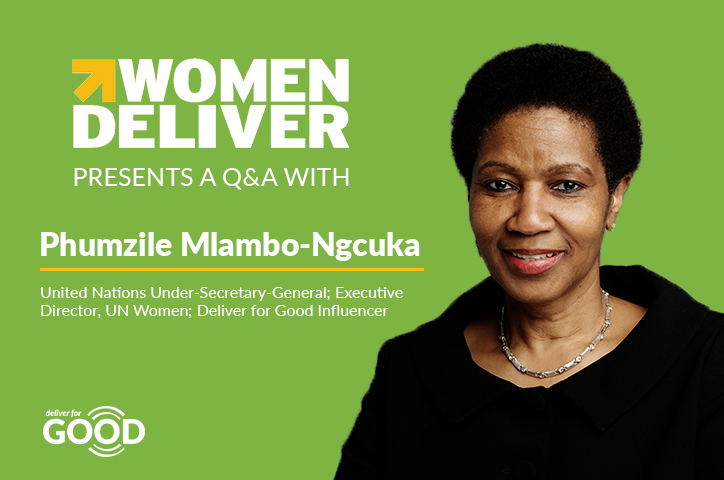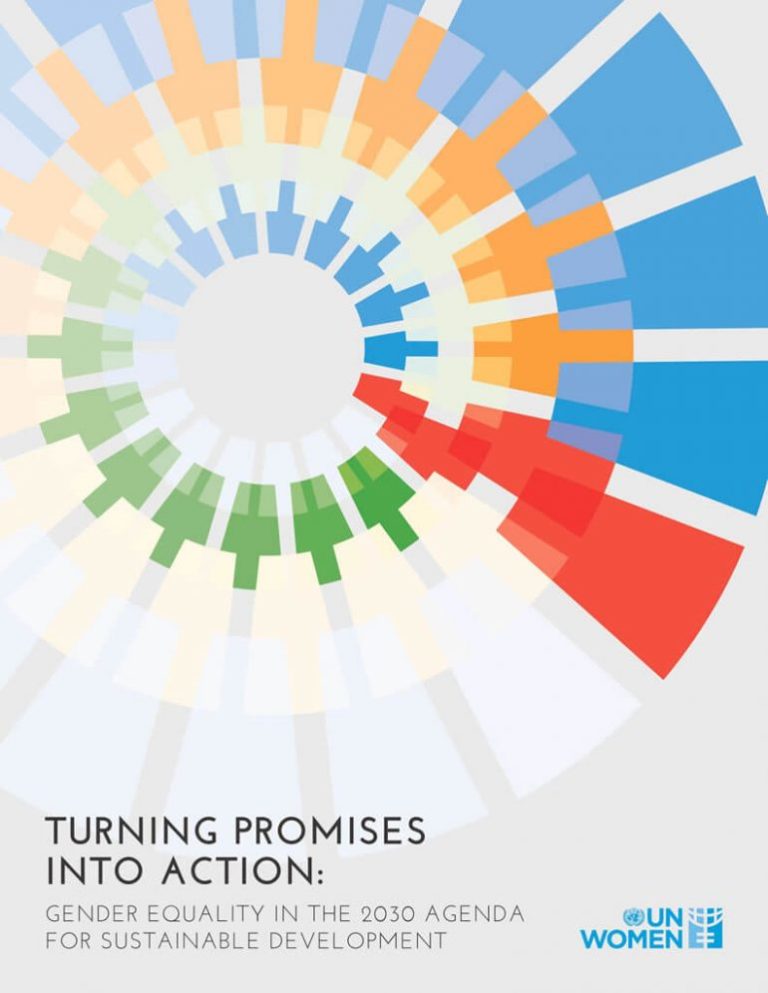Making Girls & Women Count: A Q&A with Phumzile Mlambo-Ngcuka, Executive Director of UN Women
“What cannot be measured cannot be managed. If we do not gather the data we need, we will never know if we are delivering on our promises,” – UN Secretary General Ban Ki-moon.
Achieving progress for girls and women requires accurate, gender disaggregated data to help policy makers, civil society organizations, and advocates make informed decisions about policies and programs that affect the lives of girls and women. If we do not understand the reality in the communities we work, we can’t identify the best solutions. It's that simple. And it's that important.
But data is about more than numbers. It's about individual girls and women. And it's about making sure every life is counted.
As a passionate advocate for gender equality with a strong commitment to closing the gender data gap, Phumzile Mlambo-Ngcuka, UN Under-Secretary-General, Executive Director of UN Women, and Deliver for Good Influencer is the perfect guest to join us for a conversation on role of data and accountability in advancing gender equality – this month’s focus for the Deliver for Good campaign.

1. Katja Iversen: The latest UN women report “Turning Promises to Action” presented extensive research findings on gaps and opportunities to advance gender equality – including through the use of data. What are some of the key opportunities we can leverage to “turn promises into action”?
Phumzile Mlambo-Ngcuka: Based on robust data and expert analysis, our report raises the alarm that currently in many areas, progress is too slow to achieve the Sustainable Development Goals (SDGs) by 2030. Crucially, it also pinpointed where the gaps are. That’s the biggest opportunity – for really focusing accountability, by using the power of good data that delves deep down into national statistics to locate which women and girls are being left behind. Averages don’t tell us who is being left out. We know that there are stark inequalities among women that are influenced by factors like where they live, their race and ethnicity, or their income. And that when those elements combine, they can create the circumstances that restrict crucial life choices for those women. Take the difference in the risks involved in childbirth, depending on whether you live in the city or the countryside. A woman living in a rural area of Colombia is 12 times as likely as a woman in a town or city in the same country to give birth without a skilled health professional attending. One of the areas where we have not yet made enough progress is in reducing maternal mortality. The power of data is to illuminate who is most at risk so that policy and action can follow.
So, better data and greater accountability are key to accelerate progress and close the gaps. On the data front, the challenges for gender-sensitive monitoring are enormous. Six out of the 17 SDGs lack a gender-specific indicator that tracks progress for women and girls; only 23 per cent of the data needed to monitor the 54 gender-specific indicators in the global framework is recent (i.e. from 2010 or later); and only 16 per cent of it is available for two or more points in time—meaning that we can actually monitor trends.
The 2030 Agenda presents us with an enormous opportunity to advance gender statistics by investing in national statistical systems and strengthening their capacity to collect data that measures progress for women and girls in a meaningful way. At the global level, we have an opportunity in 2020 to strengthen the indicator framework, pushing for the inclusion of gender-specific indicators, for example, under SDG 6 (water and sanitation) and SDG 7 (sustainable energy). These goals are currently gender-sensitive at the target level, but we are not yet measuring progress for women and girls through concrete indicators.
2. Katja Iversen: Increasing access and use of data is critical but it isn’t the “sexiest” topic and is difficult to humanize. When we discuss the need for age and gender disaggregated data, it can be difficult for some to understand why these distinctions are important. What can we do to make data more accessible, clear, and human so that all people – not just statisticians – understand the impact and importance?
Phumzile Mlambo-Ngcuka: Data are about real people. Think about a girl married before the age of 18: she is likely to become pregnant too early, burdened with caring for both children and elderly relatives, and deprived of education and access to a livelihood. These will elevate her risk of poverty and of abuse and she is likely to experience these deprivations more acutely if she is from a marginalized group. But you will not know about this young woman and the challenges she faces from aggregate statistics. This is how she and others like her become effectively invisible. Capturing the risks that this young woman faces requires data that are disaggregated by sex and age as well as other characteristics associated with disadvantage, for example her race and ethnicity.
In a world where inequalities of all kinds are on the rise, disaggregation by sex alone is insufficient for monitoring outcomes among women and girls.
Other forms of structural inequality intersect and compound gender-based inequalities, leaving certain groups of women and girls behind across a range of development indicators. Being female, after all, is not synonymous with being poor. It is the intersection of gender with other forms of discrimination that pushes women and girls from poor and marginalized groups behind. And it is for this reason that data disaggregated by sex, age and other characteristics are so important.
Our work on gender and poverty is another good example: globally, there are 122 women aged 25-34 for every 100 men of the same age group living in extreme poverty. That’s 22 per cent more women than men living on less than $1.90 a day at the age when they are most likely to have young families and considerable needs. Disaggregation by sex alone would conceal these disparities.
Making these stories more accessible and attractive to non-technical audiences is a challenge – but not impossible. For example, infographics can be very helpful. At UN Women we produce infographics tailored for non-technical audiences in multiple languages. We also invest a lot of time and energy disseminating information via blogs, videos, tweets and other social media platforms.
3. Katja Iversen: Collecting data must go beyond the global or even national levels. It must be localized and work with community members – including in the hardest to reach areas – to understand the realities girls and women face. Partnerships like EM2030 are working with grassroots organizations to build local capacity to collect and interpret data. What are some of the most effective strategies and initiatives you have seen advocates and organizations use to ensure quality, gender sensitive data are collected at the most grassroots local levels? And what is UN Women doing to support data and accountability work at the country and regional level, particularly in monitoring SDG implementation?
Phumzile Mlambo-Ngcuka: To capture the most complete and relevant data we need to be working at all levels.
Through our gender statistics programme, “Making Every Woman and Girl Count” (MEWGC) UN Women aims to bring about a radical shift in how gender statistics are created, used and promoted at the global, regional and national levels. Working together with governments, civil society, academia and other international agencies, and partners such as the Bill & Melinda Gates Foundation, the programme is supporting efforts to increase the availability of data on gender equality and women’s rights in order to inform policy and decision-making.
At the country level, the programme will be piloted in 12 pathfinder countries in partnership with their national statistical offices (Bangladesh, Kenya, Morocco, Nepal, Senegal, Tanzania, Uganda, Jordan, Albania, Colombia, Cameroon and Sierra Leone) and in coordination with other actors. At the regional level, we are setting up technical support projects to help countries dismantle barriers to the regular production of gender statistics and to implement national plans to monitor the SDGs. Currently the programme is operating in 3 regions (Asia and the Pacific; Europe and Central Asia and East and Southern Africa).
Lately there has also been significant attention on harnessing alternative data sources, such as citizen-generated and project and programme-level data, which have potential to complement official sources by providing data that is timely, disaggregated by sex, age and other relevant characteristics, and that can be used for monitoring and reporting on SDG implementation.
4. Katja Iversen: How did you become interested in this work? Can you share a story or experience that has continued to inspire and focus you throughout your career in advancing gender equality?
Phumzile Mlambo-Ngcuka: Well, my mother was an activist and therefore I had a strong role model for women’s activism, which gave me an impression at an early age that the woman’s role is to fight for other women and to lead. My earliest memory of my family set-up was of strong women advocating and leading change. And so I thought that’s what my life is.
5. Katja Iversen: Why are you passionate and committed to data as a mechanism for advancing gender equality? Please provide an example or story from your career when you have seen gender responsive data drive progress for girls and women in the global south?
Phumzile Mlambo-Ngcuka: The ability to make evidence-based decisions is critical. On gender equality, in particular, sometimes there is an illusion of exaggerated success about how far we have come. As women, the more we fight the more people - and even young people - think that the battle has been won. But when you present data – for instance, about how many women are in decision-making bodies, unequal pay or the number of discriminatory laws limiting women’s rights and opportunities - then you get people to see that we are still far from winning the battle. It tempers the illusion of that exaggerated success. It is a good way to gauge our success but also to make us be realistic, because we have come so far that we may think that we have already achieved our goals.
What data help us to see is that we have come far, but not far enough.
Data, like that in our new SDG report, helps us to pace ourselves, to be targeted in addressing areas where are we failing, and to be accountable for progress.



